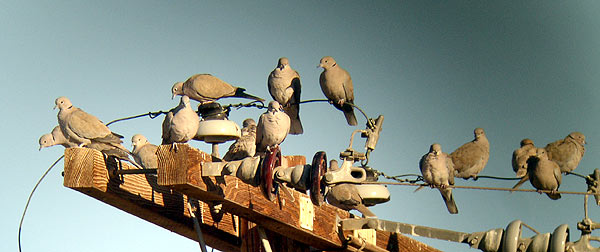 a Ringed Turtle-Dove. Two other birds were somewhat more creamy in color (below right). Several others
looked typical except their wing-tips were not as dark as expected.
a Ringed Turtle-Dove. Two other birds were somewhat more creamy in color (below right). Several others
looked typical except their wing-tips were not as dark as expected.Eurasian Collared-Dove
Calipatria, Imperial County, California
27-28 December 2002
Joseph Morlan
 I was intrigued by reports
of over 50 Eurasian Collared-Doves at the west end of Calipatria so Robbie Fischer and I stopped by the pig pen
at the intersection of Eddins and Sperry to assess the situation. We easily saw 30 Eurasian Collared-Doves the
first day and I felt there may well have been 50 or more the next day. They flew back and forth, sometimes landing
on the haystacks behind the pig pen. On 28 December, we also saw a single White-winged Dove associating with them.
I was intrigued by reports
of over 50 Eurasian Collared-Doves at the west end of Calipatria so Robbie Fischer and I stopped by the pig pen
at the intersection of Eddins and Sperry to assess the situation. We easily saw 30 Eurasian Collared-Doves the
first day and I felt there may well have been 50 or more the next day. They flew back and forth, sometimes landing
on the haystacks behind the pig pen. On 28 December, we also saw a single White-winged Dove associating with them.
I took no formal description at the time, but attempted to photograph them with the results you see here.
Most of the birds were typical of Eurasian Collared-Dove showing dark wing tips and undertail coverts. However,
at least one bird was much whiter than the others and resembled a Ringed Turtle-Dove. Two other birds were somewhat more creamy in color (below right). Several others
looked typical except their wing-tips were not as dark as expected.
a Ringed Turtle-Dove. Two other birds were somewhat more creamy in color (below right). Several others
looked typical except their wing-tips were not as dark as expected.
Apparently Eurasian Collared-Doves hybridize rather freely with escaped doves (hybridization with Ringed Turtle-Dove has been documented near Brawley). The Ringed Turtle-Dove is a smaller bird than Eurasian Collared-Dove, but all the birds we saw appeared to be about the same size. Thus I'm not sure any other pure species were involved. The few vocalizations I heard were consistent with Eurasian Collared-Dove and not with Ringed Turtle-Dove, but the birds were mostly silent.
This species is not yet on the California State list although several reports of single birds from the Imperial Valley and elsewhere have been submitted. I have taken a cautious approach to these birds, partly because there is an established introduced population in Ventura County and a number of sightings elsewhere (e.g. Monterey County) have been tracked to known releases. However, this species is expanding its range across the southern tier of the United States and the fairly large number of birds at Calipatria seem to suggest that the bird has arrived in numbers. Perhaps it is time to consider adding this species to the California State list.